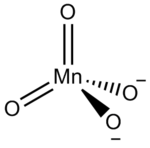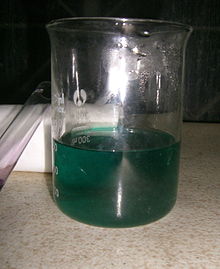- Manganate
-
In inorganic nomenclature, a manganate is any negatively charged molecular entity with manganese as the central atom.[1] However, the name is usually used to refer to the tetraoxidomanganate(2−) anion, MnO2−
4, also known as manganate(VI) because it contains manganese in the +6 oxidation state.[1] Manganates are the only known manganese(VI) compounds.[2]Contents
Manganate(VI)
The manganate(VI) ion is tetrahedral, similar to sulfate or chromate: indeed, manganates are often isostructural with sulfates and chromates, a fact first noted by Mitscherlich in 1831.[3] The manganese–oxygen distance is 165.9 pm, about 3 pm longer than in permanganate.[3] As a d1 ion, it is paramagnetic, but any Jahn–Teller distortion is too small to be detected by X-ray crystallography.[3] Manganates are dark green in colour, with a visible absorption maximum of λmax = 606 nm (ε = 1710 dm3 mol−1 cm−1).[4][5] The Raman spectrum has also been reported.[6]
Preparation
Sodium and potassium manganates are usually prepared in the laboratory by stirring the equivalent permanganate in a concentrated solution (5–10 M) of the hydroxide for 24 hours[4] or with heating.[7]
- 4 MnO−
4 + 4 OH− → 4 MnO2−
4 + 2 H2O + O2
Potassium manganate is prepared industrially, as an intermediate to potassium permanganate, by dissolving manganese dioxide in molten potassium hydroxide with potassium nitrate or air as the oxidizing agent.[2]
- 2 MnO2 + 4 OH− + O2 → 2 MnO2−
4 + 2 H2O
Uses
Manganates, particularly the insoluble barium manganate, BaMnO4, have been used as oxidizing agents in organic synthesis: they will oxidize primary alcohols to aldehydes and then to carboxylic acids, and secondary alcohols to ketones.[8][9] Barium manganate has also been used to oxidize hydrazones to diazo compounds.[10]
Disproportionation
Manganates are unstable towards disproportionation in all but the most alkaline of aqueous solutions.[2] The ultimate products are permanganate and manganese dioxide, but the kinetics are complex and the mechanism may involved protonated and/or manganese(V) species.[11][12]
Manganic acid
Manganic acid cannot be formed because of its rapid disproportionation. However, its second acid dissociation constant has been estimated by pulse radiolysis techniques:[13]
Manganate(V)
The manganate(V) anion, MnO3−
4, known trivially as hypomanganate and systematically as tetraoxidomanganate(3−), is a bright blue species[14] with a visible absorption maximum of λmax = 670 nm (ε = 900 dm3 mol−1 cm−1).[4][5] It is unstable towards dispropotionation to manganate(VI) and manganese dioxide, although the reaction is slow in very alkaline solution (c(OH−) = 5–10 mol dm−3).[14]Hypomanganates may be prepared by the careful reduction of manganates with sulfite,[14] hydrogen peroxide[15] or mandelate.[5] Only potassium hypomanganate has been studied to any significant extent. Hypomanganic acid cannot be formed because of its rapid disproportionation, but its third acid dissociation constant has been estimated by pulse radiolysis techniques:[13]
Cyclic esters of hypomanganic acid are thought to be intermediates in the oxidation of alkenes by permanganate.[5]
Manganate(IV) and manganate(III)
The manganate(IV) anion has been prepared by radiolysis of dilute solutions of permanganate.[13][15] It is mononuclear in dilute solution, and shows a strong absorption in the ultraviolet and a weaker absorption at 650 nm.[13]
Most so-called "manganites" do not contain discrete oxoanions, but are mixed oxides with perovskite (LaMnIIIO3, CaMnIVO3), spinel (LiMnIII,IV
2O4) or sodium chloride (LiMnIIIO2, NaMnIIIO2) structures. One exception is potassium dimanganate(III), K6Mn2O6, which contains discrete Mn2O6−
6 anions.[16]References
- ^ a b International Union of Pure and Applied Chemistry (2005). Nomenclature of Inorganic Chemistry (IUPAC Recommendations 2005). Cambridge (UK): RSC–IUPAC. ISBN 0-85404-438-8. pp. 74–75, 77–78, 313, 338. Electronic version..
- ^ a b c Cotton, F. Albert; Wilkinson, Geoffrey (1980), Advanced Inorganic Chemistry (4th ed.), New York: Wiley, p. 746, ISBN 0-471-02775-8.
- ^ a b c Palenik, Gus J. (1967), "Crystal structure of potassium manganate", Inorg. Chem. 6 (3): 507–11, doi:10.1021/ic50049a016.
- ^ a b c Carrington, A.; Symons, M. C. R. (1956), "Structure and reactivity of the oxy-anions of transition metals. Part I. The manganese oxy-anions", J. Chem. Soc.: 3373–80, doi:10.1039/JR9560003373.
- ^ a b c d Lee, Donald G.; Chen, Tao (1993), "Reduction of manganate(VI) by mandelic acid and its significance for development of a general mechanism of oxidation of organic compounds by high-valent transition metal oxides", J. Am. Chem. Soc. 115 (24): 11231–36, doi:10.1021/ja00077a023.
- ^ Juberta, A. H.; Varettia, E. L. (1982), "Normal and resonance Raman spectra of some manganates", J. Mol. Struct. 79: 285–88, doi:10.1016/0022-2860(82)85067-9.
- ^ Nyholm, R. S.; Woolliams, P. R. (1986), "Manganates(VI)", Inorg. Synth. 11: 56–61.
- ^ Procter, G.; Ley, S. V.; Castle, G. H. (2004), "Barium Manganate", in Paquette, L., Encyclopedia of Reagents for Organic Synthesis, New York: Wiley, doi:10.1002/047084289.
- ^ Firouzabadi, Habib; Mostafavipoor, Zohreh (1983), "Barium Manganate. A Versatile Oxidant in Organic Synthesis", Bull. Chem. Soc. Jpn. 56 (3): 914–17, doi:10.1246/bcsj.56.914.
- ^ Guziec, Frank S., Jr.; Murphy, Christopher J.; Cullen, Edward R. (1985), "Thermal and photochemical studies of symmetrical and unsymmetrical dihydro-1,3,4-selenadiazoles", J. Chem. Soc., Perkin Trans. 1: 107–13, doi:10.1039/P19850000107.
- ^ Sutter, Joan H.; Colquitt, Kevin; Sutter, John R. (1974), "Kinetics of the disproportionation of manganate in acid solution", Inorg. Chem. 13 (6): 1444–46, doi:10.1021/ic50136a037.
- ^ Sekula-Brzezińska, K.; Wrona, P. K.; Galus, Z. (1979), "Rate of the MnO4−/MnO42− and MnO42−/MnO43− electrode reactions in alkaline solutions at solid electrodes", Electrochim. Acta 24 (5): 555–63, doi:10.1016/0013-4686(79)85032-X.
- ^ a b c d Rush, J. D.; Bielski, B. H. J. (1995), "Studies of Manganate(V), -(VI), and -(VII) Tetraoxyanions by Pulse Radiolysis. Optical Spectra of Protonated Forms", Inorg. Chem. 34 (23): 5832–38, doi:10.1021/ic00127a022.
- ^ a b c Greenwood, Norman N.; Earnshaw, A. (1984). Chemistry of the Elements. Oxford: Pergamon. pp. 1221–22. ISBN 0-08-022057-6..
- ^ a b Lee, Donald G.; Chen, Tao (1989), "Oxidation of hydrocarbons. 18. Mechanism of the reaction between permanganate and carbon-carbon double bonds", J. Am. Chem. Soc. 111 (19): 7534–38, doi:10.1021/ja00201a039.
- ^ Brachtel, G.; Hoppe, R. (1976), "Das erste Oxomanganat(III) mit Inselstruktur: K6[Mn2O6]", Naturwissenschaften 63 (7): 339, doi:10.1007/BF00597313.
Categories:- Oxoanions
- Manganates
- 4 MnO−
Wikimedia Foundation. 2010.


